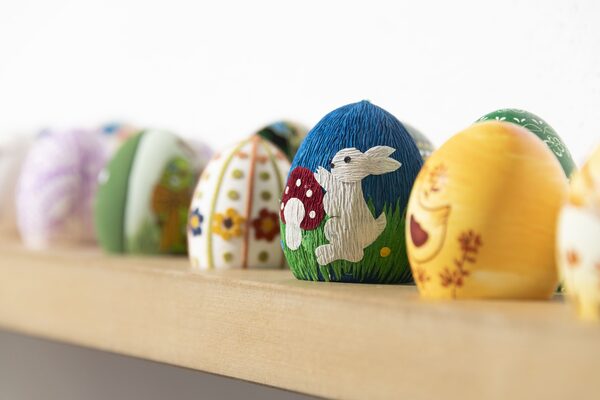Oological studies - The origin lies in the egg
The egg is of great importance to us all. We were born from it, we celebrate with it and we feed from it. The study exhibition "Oological Studies - The Origin is in the Egg" looks at various aspects from April 10 to October 19, 2025: It focuses on the biological egg and its benefits.
Two collections provide the basis for this. Firstly, there is a bird egg collection in the Natural History Collections that was started in the early 20th century. Today, it comprises around 8,000 eggs from 550 mainly European bird species. On the other hand, a cultural-historical egg collection was acquired from Dr. Birgit Scheps in 2024. Her inventory of more than 3,000 Easter eggs still requires a lot of time and voluntary commitment - for which the museum is very grateful.
Biology
The use of eggs goes hand in hand with multicellularity and more complex reproductive strategies. Thanks to the division of labour, specialized cells are found for the first time. In addition to somatic cells, others are used exclusively for reproduction. These sex cells have a single set of chromosomes (haploid) compared to normal somatic cells. We speak of eggs when, in the case of sexual reproduction, the female, generative cell is clearly different from the male form. Most fish are free spawners, i.e. they release a large number of eggs into the water. These are fertilized by the male's sperm, which is also released freely. Relatively few fish engage in brood care or, for example, attach their eggs to structures.
The eggs of amphibians are usually coated with a layer of gel that swells in the water. In shallow waters, this contributes significantly to increasing the temperature by acting like a burning glass.
Organisms had to overcome numerous difficulties before moving to land. Some of these also affected the egg, because on the one hand there was the threat of desiccation on land, and on the other hand suffocation if there was too much protection against desiccation. The solution was found around 320 million years ago by creating a third egg shell inside the egg, the amnion. This provides a protected pond outside the water, so to speak. The embryo develops in an amniotic sac filled with amniotic fluid. To this day, scaly lizards, turtles, crocodiles, birds and mammals have benefited from this. As the Max and mini exhibition on the mezzanine floor illustrates, there are huge differences in size between related species in living nature. Eggs are also affected by this. The smallest known bird's egg comes from the hummingbirds (Trochilidae) and is just 11 millimetres long. At 0.4 grams, it accounts for around 17 percent of the total body weight. Today, the ostrich egg (Struthio camelus) is the largest with a length of 15 centimeters and a weight of up to 1.8 kilograms. This corresponds to about 30 chicken eggs. In relation to its body size, however, this egg is small, accounting for just under two percent of its total body weight.
Cultural history
Spring, the time of awakening in nature, has been welcomed by many peoples in our latitudes with festivals and various customs since time immemorial. These spring festivals were once dedicated to the pre-Christian spring goddess "Ostarun". The word "Easter" was then derived from her. Numerous European Easter customs go back to the pre-Christian spring festivals. Since the 17th century, these have included the now widespread practice of looking for and giving away dyed Easter eggs or eggs decorated using various elaborate techniques.
Dyeing and painting eggs is a very old custom. It has been known to us from Germany since at least the 4th century. In Eastern Europe, gold-colored eggs were preferred, while in Central and Western Europe they were dyed red and have been called "Easter eggs" since at least the beginning of the 17th century. Other coloring and decorating techniques were then developed, such as the etching and scratching technique, wax bossing (the application of colored wax) and the wax batik technique, the sewing and embroidering of eggs. Among the many painted eggs from Eastern and South-Eastern Europe, those of the Hutsuls (a people who live in a number of South-Eastern European countries apart from Poland) are particularly striking, with their ever-changing traditional patterns. The wooden eggs from Bulgaria are decorated with notched patterns, branding and decals with religious content. The often elaborately designed wooden eggs from Russia are painted with motifs from religion and the world of fairy tales, nature and folklore. In many non-European, non-Christian cultures, too, the egg was and is regarded as the source of all life.
